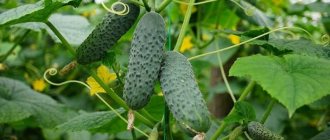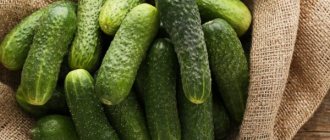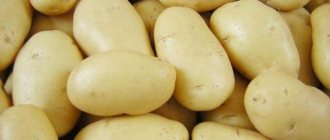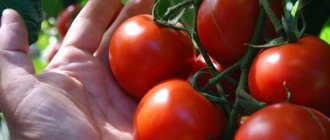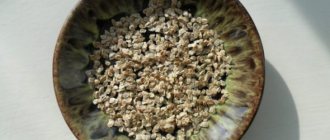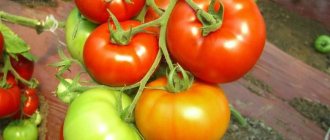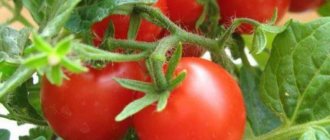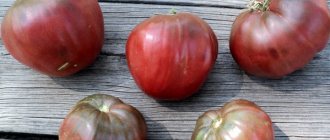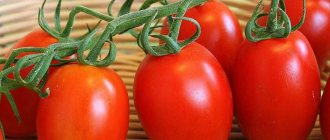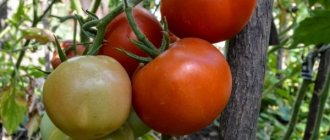Description of qualities
You can only compare the Director with his advanced Dutch brothers, because there is no point in comparing, for example, top-level athletes, world champions with backyard physical education enthusiasts.
It is considered mid-season; under normal conditions, it begins to bear fruit within 40–50 days from germination. However, in practice, it outstrips its mid-ripening counterparts, for example, Herman, by about 5–7 days, so it has a tendency towards early-ripening hybrids.
Therefore, its completely correct designation is early-mid-ripening.
The fruits have a beautiful presentation, unrivaled on the shelves, “just like in the picture.” Noble malachite, rich dark green color, almost without white stripes, light pubescence.
It is optimal to collect fruits up to 12 cm in size and weighing up to 80 g. Of course, if you wish, you can collect greens in the size of pickles - 3-5 cm, and in the size of stables - 5-8 cm, but this will lead to a shortfall in the total weight of the crop.
There is also little point in growing seedlings larger than 100 g - this is already a non-commercial coarse fruit, also purely for amateurs. And it also leads to a loss of the total weight of the crop, because the vine devotes all its energy to the growth of large fruits and the growth of new ovaries slows down.
It tolerates shade better than other Dutch hybrids.
In terms of care, it is no different from its series.
The greens are juicy, tasty, with a small amount of small soft seeds. Without the tendency to bitterness, which sometimes occurs in greens of all varieties due to the presence of the protective substance cucurbicitan in the fruits.
differ from other hybrids in darker color
Self-pollinating. The best results are obtained when grown in closed ground - greenhouses, film tunnels, temporary shelters.
Productivity is high and long lasting.
It goes well on salads and in non-airtight pickling. Opinions differ regarding canning under an airtight lid.
Seed growing method
Director is no different from most other varieties when it comes to sowing. So, their seeds can be sown in the ground along with others. If desired, you can put already slightly swollen seeds in the ground and also those that have hatched with greenery
But you must remember an important rule: parthenocarpic and bee-pollinated plant species must be planted far from each other
Plant cucumbers according to the formula - 50*50 cm. You need to plant the seed in the ground about 3 cm, but not higher. In one hole you formed you need to place 2 seeds at once. Later, the bad seedlings will be culled and the strong will push out the weak.
Choose the right place to plant
If you want the seeds to germinate quickly, you need to understand what the temperature should be. For this variety it is, on average, 26 °C. If you are going to directly sow seedlings, you need to follow the rule: the ground temperature should be at least 14 °C.
Important: before cultivating the beds, you need to disinfect them with a 0.05% solution of potassium permanganate. After this, the beds must be dug up
The greatest harvest effect can be achieved from a cucumber variety if you plant the plant in the ground on which early potatoes, cabbage of any kind or legumes previously grew, but not beans, which will not benefit the cucumbers.
Disadvantages of the variety
- High cost of seeds.
- The yield of the harvest is not even and gradual, but in waves - “sometimes thick, sometimes empty.”
- High demands on proper agricultural technology.
- Prone to thickening due to the large number of shoots.
- More than others it requires warmth.
Objectively, it must be said that these are very relative disadvantages.
Simple approximate calculations. A hybrid seed worth 8 rubles. gives a bush with a potential yield of 10 kg. 50 rubles each, totaling 500 rubles.
Cucumber seeds of weaker varieties cost 1 rub. or your own free one gives a bush with a harvest of 5 kg. 50 rub. in the end 250 rubles.
As a result, on the same areas, for the same time, with the same labor costs, water and fertilizer consumption, you can save 7 rubles. on one seed and lose 250 rubles. on the harvest.
The “explosive” return of the harvest is fraught only with the fact that, for example, for a week the Director will give barely enough harvest for a cup of salad, and then an avalanche of harvest will immediately fall on your head. Then - a recession, and then again a wave of harvest. Moreover, such “non-conveyor” ripening of the crop can be associated not only with the characteristics of the variety, but also with fluctuations in growth conditions from unfavorable to favorable.
Regarding the demands on agricultural technology, this is relevant for all crops at all times. It’s just that advanced Dutch varieties are especially demanding of this.
Advantages and disadvantages
Like all cucumber varieties and hybrids, Director F1 has its own advantages, for which vegetable growers love him. Those who have already grown the hybrid in garden beds or in greenhouses claim that it is different:
- high productivity;
- excellent quality and presentation of the fruit;
- immunity to diseases;
- suitability of growing in 2 turns (when sowing in spring and a second time in summer).
Director F1 cucumbers also have disadvantages. For some gardeners they are:
- demands on nutrition and soil moisture;
- the need to pinch stepchildren;
- high cost of seeds that need to be purchased annually.
This hybrid has no other disadvantages, so if you grow it responsibly, any gardener will undoubtedly like it.
Advantages of the variety
- Excellent fruit quality, both in appearance and taste.
- Good keeping quality, possibility of long-term transportation and fresh storage.
- High yield.
- A long period of fruiting, which ends only with the onset of cold weather and a reduction in daylight hours.
- The resistance to many diseases inherent in the breeding of the variety does not require preventive treatment with fungicides.
In details. The Director ends the fruiting period not because its growth period laid down by the varietal genetic mechanism has expired, but because winter is just around the corner, cold and dark. If it grows in heated greenhouses with the right, sufficient lighting, it can grow and bear fruit even longer, up to 6 months, and in ideal conditions 9-11 months.
True, in large greenhouse farms they do not keep one crop of cucumber for so long, and after the peak of the harvest has passed, they change the plantings to younger ones. Because a six-month-old old man produces, of course, less harvest. A single private owner will be happy with it in his greenhouse, but on very expensive square meters of industrial greenhouses this is no longer profitable.
Therefore, in expensive greenhouses they do not squeeze everything out of one planting, but run two rounds during the warm season.
To extend the period of growth and fruiting, you need to carry out simple but specific care techniques.
Diseases and pests
This variety has strong immunity against many diseases due to its hybridity. The director will be able to fight back diseases such as powdery mildew, mosaic and brown spot.
According to experts, the Director cannot always cope with white mold and rot; more often this phenomenon manifests itself in greenhouse conditions. In this case, prevention must be carried out before planting.
Prevention
To prevent the fruits and bush from getting sick, it is necessary to carry out preventive spraying using the following preparations:
- based on the fungicide Previkur;
- Abiga - peak;
- Copper oxychloride (it is especially popular among gardeners).
These drugs have proven themselves to be effective preventive agents that can not only protect the root system of the plant, but also significantly affect the fruits, making them hardy and attractive, saturating them with vitamins.
The price of F1 cucumbers can be different, everything will depend on the yield and method of cultivation, since gardeners have different types of seeds, which are then put up for sale. The description confirms that this plant is ideal for any gardener.
Care
Surprisingly, Director was created by Dutch breeders specifically for open ground. In our country, perhaps due to the peculiarities of the climate, they immediately began to grow it in greenhouses, where this new hybrid showed excellent results. And in the open air it grows fully only in the southern regions.
You can achieve success in the open ground both in Central Russia and in the North-West, but for this you need to carefully maneuver the deadlines.
In the open ground
In open nature in the middle zone, the Director will be able to reveal his capabilities during the most favorable period - from the end of May to the end of July, when the daylight hours are the longest and the night temperatures are warmest. To do this, on April 15–25, the seeds are planted in containers with a capacity of at least 0.3 - 0.5 liters and grown on sunny windowsills or in a greenhouse. And only when the temperature outside is at least 22 degrees, and the soil in the garden has warmed up by at least 14 degrees, the threat of frost has passed, and the Director’s seedlings are planted in a permanent place.
On open ground in the middle zone, the Director will feel better lying on the ground. When gartered high, the winds will blow him around, but he doesn’t tolerate this well.
Without a garter up, it requires a lot of space. Between rows at least 2 m, between plants in a row 0.5 meters.
Otherwise, agricultural care techniques are common to all cucumbers.
Indoors
Immediately upon planting, you need to provide the bush with fertile, loose soil. In the Central Black Earth zone, local undepleted black soil with wood ash is sufficient at the rate of 0.5 liters of ash per 10 liters of soil.
If the chernozem is not virgin, from a perennial garden, you can add manure or compost humus at the rate of 3–5 liters per 10 liters of soil.
Humus, as a rule, has high acidity. Therefore, it must be neutralized by dusting with the same wood ash, dolomite flour, chalk or quicklime while stirring. Moreover, fluff also has properties to disinfect the soil.
Before fruiting begins, water with warm standing water every two days, from the beginning - every day, with the exception of cloudy days. Although the time interval is not the main criterion. Because in sunny and rainy weather, small and large bushes have completely different watering needs. The main thing is to ensure that the soil does not dry out and always remains moist.
If a leaf in a greenhouse has wilted or lost its tugort, this means that it is necessary to urgently water it both at the root and by spraying it on the foliage. This is often due not only to the drying out of the soil, but also to too high a temperature in the greenhouse due to powerful sunlight. The director tolerates a daytime increase in air temperature in the greenhouse to 45 degrees, but already from 40 degrees it is necessary to open the greenhouse openings for ventilation. 50 degrees and above, which is quite likely under shelters on a hot sunny day, is already critical overheating for all plants. Then the flowers begin to be sterilized and will not set, and the foliage will “burn” and dry out.
Cold water greatly damages the root system.
Director is a powerful plant of intensive growth type with an extensive superficial root system, and with watering, when the soil shrinks, and during development, the roots often come to the surface. This should not be allowed; they must be regularly sprinkled with loose nutrient soil or humus.
Director F1 in the greenhouse approximately on the 55th day after germination
Planting scheme in closed ground - 3 plants per 1 sq. m. When 5–6 true leaves appear, the bush is tied either to a cord attached to the arches of the greenhouse under the ceiling, or to a stand driven into the ground. As it grows, the stem is tied several times a season.
There will always be debate about the correct formation of the whip. Some farmers leave one stem, others two or three, and there are supporters of not carrying out “amputation of limbs” on plants at all.
The most surprising thing is that in all three cases the Dutch will still produce approximately the same harvest. But in the first case you will have neat, strict rows, in the second you will have more spreading plantings, shading each other. But since the Director tolerates shading better than others, this option is quite acceptable for him.
But in the third case, you will get a real impassable jungle. The lashes will grow upward along the trellises, lie on the ground, and cling with their tendrils to everything that is nearby.
In this case, harvesting will be difficult. This applies to all varieties, and Director especially. It produces a lot of side shoots - stepchildren, which will have to be cut off. Otherwise, you can overload the root system with excessive green mass of the thickets to the detriment of the harvest.
How to prolong fruiting
Until mid-August, in closed ground, the Director bears fruit as usual. Then the lashes begin to dry out, but one or two young shoots remain alive and grow. By this time, the plant had developed a root system that provided nutrition to the huge bush, and as soon as you give it powerful feeding, new shoots will immediately begin to grow.
You can give a “second wind” with two types of fertilizers.
Fertilizing with mineral fertilizers
To increase the green mass of vines, use nitrogen fertilizer, urea urea, 40 g per 10 liters of warm water. For normal fruit development - diammophos - 20 g per 10 liters of water. It is quite possible to use these two types of fertilizers together in 10 liters of water. Before fertilizing, make sure that the roots do not stick out on the surface and moisten the soil with clean warm water so as not to burn the fibrous roots.
You can use other combinations of fertilizers recommended for regular feeding of all varieties of cucumbers.
Fertilizing with organic fertilizers
40 liters of duckweed, mud and other algae caught in a river or pond are soaked in 200 liters of water for 3-4 days or more. The cucumbers are directly watered with this water.
For many other ordinary varieties with a limited growing season, this method of prolonging fruiting will not help; by this time they simply die off completely.
The same fertilizing is recommended during the entire growth period, but the concentration must be reduced by two. Use 20g and 10g of mineral fertilizers, not 40g and 20g, and dilute the algae infusion with clean water 1:1.
Features of agricultural technology
For this variety, there are two types of cultivation: open ground and seedling method. The hybrid form in terms of sowing is practically no different from most other varieties. Their seeds are placed in the ground slightly swollen. The ground temperature should be at least 15 degrees Celsius. Before planting, the soil must be thoroughly dug up and disinfected; it is advisable to do this in advance, for example, in the fall.
Advice! With the seed growing method, you can sow two grains at once in order for rejection to occur. Bad shoots will fade into the background and the strong will push out the weak.
You can resort to using trellises to form bushes in open ground conditions. The trellis must be fixed to the ground, at least two meters high. It can be made from wood. Tie the bushes to a trellis net. This makes caring for plants even easier.
You may be interested in:
Bush cucumbers (for open ground and greenhouses) - self-pollinating varieties Bush cucumbers are hybrids characterized by their compact size and weak branching. On short stems such...Read more...
The seedling method is simpler: planting is done with ready-made plants. If you follow certain steps, you will get a rich harvest:
- planting depth no more than 2 cm;
- when the first leaves appear, it is necessary to feed the roots;
- keep the soil moist.
Summer residents advise arranging plants in a checkerboard pattern to simplify care. Seedlings should be planted in such a way that there is at least 30 centimeters between plants, and a meter between rows, in open ground conditions. For every m2 there should be about four plants.
For good fruiting, it is necessary to care for the plants. Firstly, if you use the seedling method of growing, you need to water regularly and monitor the soil moisture. If you use the open ground method, you need to water more often, as there are dry days. It is recommended to moisturize in the evening. Secondly, fertilizing must be done frequently.
Summer residents use various solutions and home remedies. Also used:
- ash;
- humus;
- manure.
Thirdly, the variety needs to be formed, so excess pieces must be removed with garden shears, pinched, and the plant must be tied up, as it grows very quickly.
Recommendation! To achieve the greatest harvest, summer residents are advised to plant seeds or seedlings in the ground in which potatoes, cabbage or legumes grew. The land where the beans grew will not benefit the cucumbers.
Reviews about the variety
We tried it in the fall by the Director of F1 (Nunhems). Sowed on July 1, August 1 - first harvest, abundantly from August 7. Dark green, tastes good, yield is also good. Again, in different seasons the ripening time, conditions and harvest are different. We didn't grow it in the spring, but liked it in the fall.
User Maria29, Krasnodar region
https://forum.tepli4ka.com/viewtopic.php?f=9&p=15240
There are several people in our company who are amateur gardeners, so we chip in and order seeds in bulk, it turns out much cheaper and there is no mis-sorting. We ordered seeds in a professional package - 1000 pieces, although there were also seeds in a package - 500 pieces (price per package - 2090 rubles). The cost of a large package (1000 pcs.) cost 2931 rubles, it turns out 1 seed is about 3 rubles, if you buy it in a store in a small package, the same seeds will cost at least 8 rubles. per piece So consider how much more profitable it is to order in bulk.
User Foxi1502
https://irecommend.ru/content/samye-pervye-ogurchiki-so-svei-gryadki-vsegda-samye-luchshie
“I’ve been planting cucumbers for F1 Director for several years now and I’m very pleased. Since this variety is shade-tolerant, I plant it in early spring to get the first cucumbers. And a little later I sow other varieties. The seeds are processed, so they do not require soaking. Cotyledon leaves appear on the third day. Absolutely all seeds germinate! Three weeks later, my seedlings already have three leaves, and I plant them in open ground. The plant grows and develops well, and in May my family eats salads from homemade cucumbers.”
Maria, 45 years old
https://agrouchastok.ru/ovoshhi/ogurcy/direktor-f1-opisanie-i-otzyvy.html
Hybrid parthenocarpic varieties of cucumbers
Harvest, harvest and once again harvest – that’s what interests both summer residents and large-scale vegetable growers. That is why breeders from all countries are committed to developing hybrid varieties of the parthenocarpic type.
Their feature is:
- Resistance to major types of diseases, which is especially important when growing this vegetable in field conditions.
- The yield from one bush significantly exceeds that of conventional hybrid and varietal greens. This is due to the fact that parthenocarpic cucumber bushes have a more powerful root and stem system.
- Their fruiting time is also longer, and some varieties, for example the Director cucumber, can be sown twice per season and harvest the same high yield either at the beginning of summer or at the end.
- Temperature changes have practically no effect on parthenocarpic varieties, which cannot be said about ordinary types or hybrid cucumbers.
- An amazing property of these greens is the absence of bitterness, even when stored for a long time.
Cucumber Director f1 belongs to this type and has all the advantages inherent in it.
Video about Director F1
The F1 director appeared with us relatively recently, and has not yet received such wide recognition as its other Dutch counterparts. But already now many professional and amateur experts who have tested this variety in practice believe that it has great prospects in our open spaces.
- Author: Gennady Chernikov
Rate this article:
- 5
- 4
- 3
- 2
- 1
(2 votes, average: 5 out of 5)
Share with your friends!


